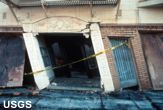Live Bacteria Could Reduce Earthquake Damage

When earthquakes strike in sandy soil, the ground can turn to a liquid-like state that proves disastrous for buildings. The phenomenon, called liquefaction, is common around bays and near the sea. It destroyed several buildings in low-lying areas in the 1989 Loma Prieta earthquake in San Francisco.
Now scientists hope to turn such sandy soils into solid rock by injecting live bacteria into the ground.
- Video: Earthquake Forecasting
Civil engineers already know they can inject chemicals into loose soil to bind grains together. But the chemicals are toxic.
A natural culture of Bacillus pasteurii along with oxygen and other nutrients causes calcium carbonate to form around sand grains, cementing them together. The structure of the soil is not changed; the gaps are simply filled in.
"Starting from a sand pile, you turn it back into sandstone," said Jason DeJong, an assistant professor of civil and environmental engineering at the University of California at Davis.
The culture is not toxic, DeJong and colleagues said. And it could be applied during or after construction.
- Images: Deadly Earthquakes
The process has been tested only in a lab setting, however. A similar technique has been used to repair cracks in statues.
Get the world’s most fascinating discoveries delivered straight to your inbox.
The researchers plan to test the process on a larger scale if funding is provided. The scheme is detailed in the Journal of Geotechnical and Geoenvironmental Engineering and was funded by the National Science Foundation.
- Earthquake Facts and Myths
- Will California Ever Fall into the Ocean?
- World's Tallest Building Possibly Causing Earthquakes
- U.S. Unprepared for Next Great Quake
- The Big Earthquake Quiz
- All About Earthquakes
Robert is an independent health and science journalist and writer based in Phoenix, Arizona. He is a former editor-in-chief of Live Science with over 20 years of experience as a reporter and editor. He has worked on websites such as Space.com and Tom's Guide, and is a contributor on Medium, covering how we age and how to optimize the mind and body through time. He has a journalism degree from Humboldt State University in California.



